Dowel
A dowel is a cylindrical rod, usually made from wood, plastic, or metal. In its original manufactured form, a dowel is called a dowel rod. Dowel rods are often cut into short lengths called dowel pins. Dowels are commonly used as structural reinforcements in cabinet making and in numerous other applications, including:
- Furniture shelf supports
- Moveable game pieces (i.e. pegs)
- Hangers for items such as clothing, key rings, and tools
- Wheel axles in toys
- Detents in gymnastics grips
- Supports for tiered wedding cakes
Wood dowel
Manufacturing process
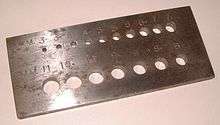
The traditional tool for making dowels is a dowel plate, an iron (or better, hardened tool steel) plate with a hole having the size of the desired dowel. To make a dowel, a piece of wood is split or whittled to a size slightly bigger than desired and then driven through the hole in the dowel plate. The sharp edges of the hole shear off the excess wood.[1][2][3]
A second approach to cutting dowels is to rotate a piece of oversized stock past a fixed knife, or alternatively, to rotate the knife around the stock. Machines based on this principle emerged in the 19th century.[4][5] Frequently, these are small bench-mounted tools.[6][7]
For modest manufacturing volumes, wood dowels are typically manufactured on industrial dowel machines based on the same principles as the rotary cutters described above. Such machines may employ interchangeable cutting heads of varying diameters, thus enabling the machines to be quickly changed to manufacture different dowel diameters. Typically, the mechanism is open-ended, with material guides at the machine's entry and exit to enable fabrication of continuous dowel rod of unlimited length. Since the 19th century, some of these dowel machines have had power feed mechanisms to move the stock past the cutting mechanism.[8][9]
High-volume dowel manufacturing is done on a wood shaper, which simultaneously forms multiple dowels from a single piece of rectangular stock (i.e., wood). These machines employ two wide, rotating cutting heads, one above the stock and one below it. The heads have nearly identical cutting profiles so that each will form an array of adjoined, side-by-side "half dowels". The heads are aligned to each other and one head is shaped to make deeper cuts along the dowel edges so as to part the stock into individual dowel rods, resulting in a group of dowel rods emerging in parallel at the machine's output.
Application
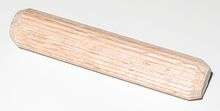
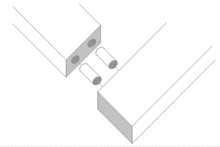
The wooden dowel rod used in woodworking applications is commonly cut into dowel pins, which are used to reinforce joints and support shelves and other components in cabinet making. Some woodworkers make their own dowel pins, while others purchase dowel pins precut to the required length and diameter.
When dowels are glued into blind holes, a very common case in dowel-based joinery, there must be a path for air and excess glue to escape when the dowel is pressed into place. If no provision is made to relieve the hydraulic pressure of air and glue, hammering the dowel home or clamping the joint can split the wood. An old solution to this problem is to plane a flat on the side of the dowel; some sources suggest planing the flat on the rough stock before the final shaping of the round dowel.[2] Some dowel plates solve the problem by cutting a groove in the side of the dowel as it is forced through; this is done by a groove screw, a pointed screw intruding from the side into the dowel cutting opening.[3] Some dowel pins are Fluted with multiple parallel grooves along their length to serve the same purpose.
When two pieces of wood are to be joined by dowels embedded in blind holes, there are numerous methods for aligning the holes. For example, pieces of shot may be placed between the wood pieces to produce indentations when the pieces are clamped together; after the clamp is released, the indentations indicate the center points for drilling.[1] Dowel centers are simple and inexpensive tools for aligning opposing blind holes. Various commercial systems, such as Dowelmax, have been devised to solve this problem.
Alternative joinery methods may be used in place of conventional dowel pins, such as Miller dowels, biscuit joiners, spline joints, and proprietary tools such as the Domino jointer.
History

The word dowel was used in Middle English; it appears in Wycliffe's Bible translation (circa 1382-1395) in a list of the parts of a wheel: "...and the spokis, and dowlis of tho wheelis..."[10] Cognates with other Germanic languages suggest that the word is much older (deuvel in Dutch, Dübel in German).
Wooden dowels have been used in manufacturing and woodworking for many centuries. One of the earliest documented uses of wooden dowels was in Japanese shrines in AD 690, which were constructed using only wood, wooden dowels and pegs, and interlocking joints. Around AD 1000, Leif Erikson sailed across the North Atlantic in a ship that was largely constructed of overlapping planks held together by wooden dowels and iron nails. The wooden dowels did not rust and thus were more reliable than iron for long expeditions.
Metal dowel
In machinery
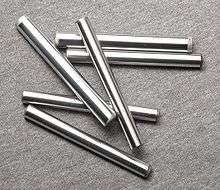
Dowel pins are often used as precise locating devices in machinery. Steel dowel pins are machined to tight tolerances, as are the corresponding holes, which are typically reamed. A dowel pin may have a smaller diameter than its hole so that it freely slips in, or a larger diameter so that it must be pressed into its hole (an interference fit).
When designing mechanical components, mechanical engineers typically use dowel holes as reference points to control positioning variations and attain repeatable assembly quality. If no dowels are used for alignment (e.g., components are mated by bolts only), there can be significant variation, or "play", in component alignment.
Typical drilling and milling operations, as well as manufacturing practices for bolt threads, introduce mechanical play proportional to the size of the fasteners. For example, bolts up to 10 mm (0.394 in) in diameter typically have play on the order of 0.2 mm (0.008 inches). When dowels are used in addition to bolts, however, the tighter dimensional tolerances of dowels and their mating holes—typically 0.01 mm (0.0004 inches)—result in significantly less play, on the order of 0.02 mm (0.0008 inches). Manufacturing costs are inversely proportional to mechanical tolerances and, as a result, engineers must balance the need for mechanical precision against cost as well as other factors such as manufacturability and serviceability.
There are a variety of specifications, military, ISO, DIN, ASME that pins may be made to. And size can even vary by dowel pin material. Metric dowel pins are often found in two size. In DIN 6325 standard the dowel pins are slightly larger than the nominal value. For example a 3 mm dowel pin will range from 3.002 to 3.008 mm (0.1182 to 0.1184 inches). In the ISO 2338 standard the dowel pins are slightly smaller - 3 mm nominal range is 2.986 to 3.000 mm (0.1176 to 0.1181 inches). The terminology (e.g. "oversized", "standard") is not entirely consistent across suppliers. In inch pins "oversized" refers to pins that are more significantly oversized for worn out dowel pin holes. The most common inch sized pins are slightly oversized, and "undersized" versions are also available.
In automobiles, dowels are used when precise mating alignment is required, such as in differential gear casings, engines, and transmissions.
Bolts in a bolted joint often have an important function as a dowel, resisting shear forces. For this reason, many bolts have a plain unthreaded section to their shank. This gives a closer fit to the hole and also avoids some problems with fretting wear when a screw thread bears against an unthreaded component.
In woodworking
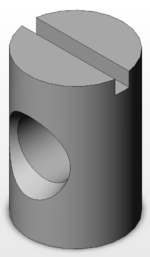
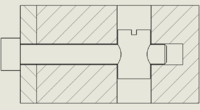
A cross dowel is a cylindrically shaped metal nut (i.e., a metal dowel) that is used to join two pieces of wood. Like other metal nuts, it has an inside threaded hole, although the hole is unusual in that it passes through the sides of the dowel. One or both ends of the dowel are slotted, with the slots oriented parallel to the threaded hole through which the bolt will pass.
In a cross dowel application, the two pieces of wood are aligned and a bolt hole is drilled through one piece of wood and into the other. A dowel hole is drilled laterally across the bolt hole and the cross dowel is inserted into it. A screwdriver is inserted into the slot at the end of the cross dowel and the dowel is rotated so that its threaded hole aligns with the bolt hole. The bolt is then inserted into the bolt hole and screwed into the cross dowel until the wood pieces are held tightly together.
See also
References
- Ivin Sickels, Exercises in Wood-Working, American Book Company, 1889; see Exercise 18.— Uniting with Dowels, pages 104-105.
- Dowel Making and Doweling, Scientific American, Vol. XLIX, No. 6 (Aug. 11, 1883); page 88.
- H. H. Parker, Making Wood Dowels, Popular Mechanics, Vol. 41, No. 6 (June, 1924); page 957.
- William H. Whitlock, Improvement in Turning Tool, U.S. Patent 83,573, granted Oct. 27, 1868.
- Sanford A. Penny, Lathe, U.S. Patent 398,077, granted Feb. 19, 1889.
- Edward A. Cherry, Tool for Forming Round Dowels and Rods, U.S. Patent 1,367,462, granted Feb. 1, 1921; this is the Stanley No. 77 Dowel and Rod Turner.
- Abdul Aziz, Leonard G. Lee and Lloyd Sevack, Dowel Maker, U.S. Patent 6,263,929, granted Aug. 26, 2001; this is the Lee Valley Veritas Dowel Maker.
- Oscar H. Ordway, Dowel Making Machine, U.S. Patent 603,965, granted May 10, 1898.
- George W. Davis, Dowel-Making Machine, U.S. Patent 1,427,073, granted Aug. 22, 1922.
- 3 Kings 7:33 in Wycliffe's Bible.